Comprehensive Review: Ethnographic Approach and Its Applications
VerifiedAdded on 2021/11/10
|7
|3156
|42
Report
AI Summary
This report provides a critical review of the ethnographic approach, examining its core characteristics, including observation in natural settings and the importance of understanding participants' perspectives. It discusses various research methods, such as participant and non-participant observation, and data collection techniques like interviewing and reviewing other sources. The report also delves into the aspects of reliability and validity in ethnographic research, highlighting the challenges of replication and generalization due to the qualitative nature of the approach. Furthermore, it explores the advantages of ethnographic research, such as its ability to provide real-world findings, and acknowledges its limitations, including potential subjectivity and time-intensive data collection. Overall, the review emphasizes the significance of triangulation and careful consideration of researcher bias to ensure the accuracy and trustworthiness of ethnographic studies. This analysis is designed to help students understand ethnographic research methodologies.
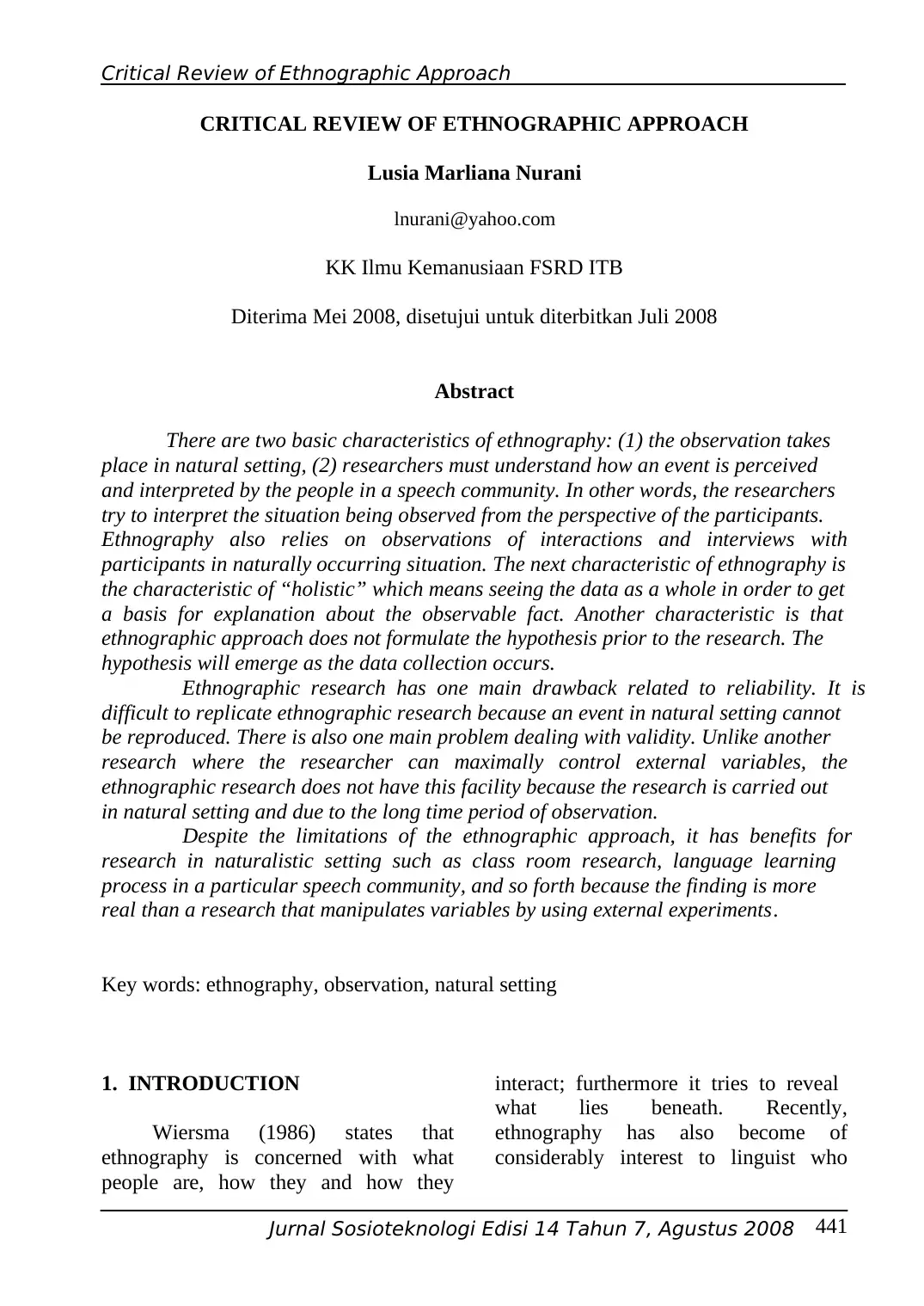
Critical Review of Ethnographic Approach
CRITICAL REVIEW OF ETHNOGRAPHIC APPROACH
Lusia Marliana Nurani
lnurani@yahoo.com
KK Ilmu Kemanusiaan FSRD ITB
Diterima Mei 2008, disetujui untuk diterbitkan Juli 2008
Abstract
There are two basic characteristics of ethnography: (1) the observation takes
place in natural setting, (2) researchers must understand how an event is perceived
and interpreted by the people in a speech community. In other words, the researchers
try to interpret the situation being observed from the perspective of the participants.
Ethnography also relies on observations of interactions and interviews with
participants in naturally occurring situation. The next characteristic of ethnography is
the characteristic of “holistic” which means seeing the data as a whole in order to get
a basis for explanation about the observable fact. Another characteristic is that
ethnographic approach does not formulate the hypothesis prior to the research. The
hypothesis will emerge as the data collection occurs.
Ethnographic research has one main drawback related to reliability. It is
difficult to replicate ethnographic research because an event in natural setting cannot
be reproduced. There is also one main problem dealing with validity. Unlike another
research where the researcher can maximally control external variables, the
ethnographic research does not have this facility because the research is carried out
in natural setting and due to the long time period of observation.
Despite the limitations of the ethnographic approach, it has benefits for
research in naturalistic setting such as class room research, language learning
process in a particular speech community, and so forth because the finding is more
real than a research that manipulates variables by using external experiments.
Key words: ethnography, observation, natural setting
1. INTRODUCTION
Wiersma (1986) states that
ethnography is concerned with what
people are, how they and how they
interact; furthermore it tries to reveal
what lies beneath. Recently,
ethnography has also become of
considerably interest to linguist who
Jurnal Sosioteknologi Edisi 14 Tahun 7, Agustus 2008 441
CRITICAL REVIEW OF ETHNOGRAPHIC APPROACH
Lusia Marliana Nurani
lnurani@yahoo.com
KK Ilmu Kemanusiaan FSRD ITB
Diterima Mei 2008, disetujui untuk diterbitkan Juli 2008
Abstract
There are two basic characteristics of ethnography: (1) the observation takes
place in natural setting, (2) researchers must understand how an event is perceived
and interpreted by the people in a speech community. In other words, the researchers
try to interpret the situation being observed from the perspective of the participants.
Ethnography also relies on observations of interactions and interviews with
participants in naturally occurring situation. The next characteristic of ethnography is
the characteristic of “holistic” which means seeing the data as a whole in order to get
a basis for explanation about the observable fact. Another characteristic is that
ethnographic approach does not formulate the hypothesis prior to the research. The
hypothesis will emerge as the data collection occurs.
Ethnographic research has one main drawback related to reliability. It is
difficult to replicate ethnographic research because an event in natural setting cannot
be reproduced. There is also one main problem dealing with validity. Unlike another
research where the researcher can maximally control external variables, the
ethnographic research does not have this facility because the research is carried out
in natural setting and due to the long time period of observation.
Despite the limitations of the ethnographic approach, it has benefits for
research in naturalistic setting such as class room research, language learning
process in a particular speech community, and so forth because the finding is more
real than a research that manipulates variables by using external experiments.
Key words: ethnography, observation, natural setting
1. INTRODUCTION
Wiersma (1986) states that
ethnography is concerned with what
people are, how they and how they
interact; furthermore it tries to reveal
what lies beneath. Recently,
ethnography has also become of
considerably interest to linguist who
Jurnal Sosioteknologi Edisi 14 Tahun 7, Agustus 2008 441
Paraphrase This Document
Need a fresh take? Get an instant paraphrase of this document with our AI Paraphraser
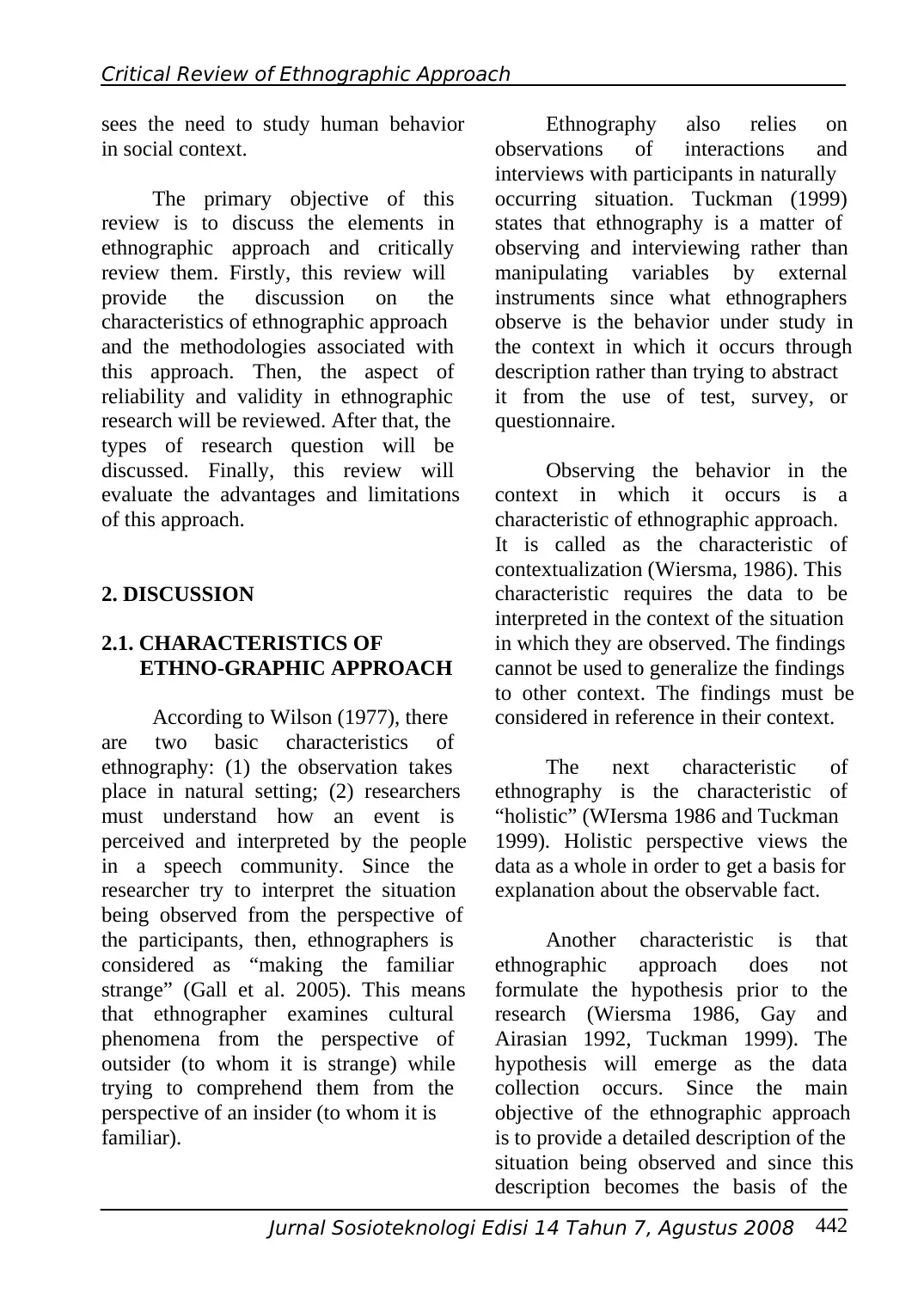
Critical Review of Ethnographic Approach
sees the need to study human behavior
in social context.
The primary objective of this
review is to discuss the elements in
ethnographic approach and critically
review them. Firstly, this review will
provide the discussion on the
characteristics of ethnographic approach
and the methodologies associated with
this approach. Then, the aspect of
reliability and validity in ethnographic
research will be reviewed. After that, the
types of research question will be
discussed. Finally, this review will
evaluate the advantages and limitations
of this approach.
2. DISCUSSION
2.1. CHARACTERISTICS OF
ETHNO-GRAPHIC APPROACH
According to Wilson (1977), there
are two basic characteristics of
ethnography: (1) the observation takes
place in natural setting; (2) researchers
must understand how an event is
perceived and interpreted by the people
in a speech community. Since the
researcher try to interpret the situation
being observed from the perspective of
the participants, then, ethnographers is
considered as “making the familiar
strange” (Gall et al. 2005). This means
that ethnographer examines cultural
phenomena from the perspective of
outsider (to whom it is strange) while
trying to comprehend them from the
perspective of an insider (to whom it is
familiar).
Ethnography also relies on
observations of interactions and
interviews with participants in naturally
occurring situation. Tuckman (1999)
states that ethnography is a matter of
observing and interviewing rather than
manipulating variables by external
instruments since what ethnographers
observe is the behavior under study in
the context in which it occurs through
description rather than trying to abstract
it from the use of test, survey, or
questionnaire.
Observing the behavior in the
context in which it occurs is a
characteristic of ethnographic approach.
It is called as the characteristic of
contextualization (Wiersma, 1986). This
characteristic requires the data to be
interpreted in the context of the situation
in which they are observed. The findings
cannot be used to generalize the findings
to other context. The findings must be
considered in reference in their context.
The next characteristic of
ethnography is the characteristic of
“holistic” (WIersma 1986 and Tuckman
1999). Holistic perspective views the
data as a whole in order to get a basis for
explanation about the observable fact.
Another characteristic is that
ethnographic approach does not
formulate the hypothesis prior to the
research (Wiersma 1986, Gay and
Airasian 1992, Tuckman 1999). The
hypothesis will emerge as the data
collection occurs. Since the main
objective of the ethnographic approach
is to provide a detailed description of the
situation being observed and since this
description becomes the basis of the
Jurnal Sosioteknologi Edisi 14 Tahun 7, Agustus 2008 442
sees the need to study human behavior
in social context.
The primary objective of this
review is to discuss the elements in
ethnographic approach and critically
review them. Firstly, this review will
provide the discussion on the
characteristics of ethnographic approach
and the methodologies associated with
this approach. Then, the aspect of
reliability and validity in ethnographic
research will be reviewed. After that, the
types of research question will be
discussed. Finally, this review will
evaluate the advantages and limitations
of this approach.
2. DISCUSSION
2.1. CHARACTERISTICS OF
ETHNO-GRAPHIC APPROACH
According to Wilson (1977), there
are two basic characteristics of
ethnography: (1) the observation takes
place in natural setting; (2) researchers
must understand how an event is
perceived and interpreted by the people
in a speech community. Since the
researcher try to interpret the situation
being observed from the perspective of
the participants, then, ethnographers is
considered as “making the familiar
strange” (Gall et al. 2005). This means
that ethnographer examines cultural
phenomena from the perspective of
outsider (to whom it is strange) while
trying to comprehend them from the
perspective of an insider (to whom it is
familiar).
Ethnography also relies on
observations of interactions and
interviews with participants in naturally
occurring situation. Tuckman (1999)
states that ethnography is a matter of
observing and interviewing rather than
manipulating variables by external
instruments since what ethnographers
observe is the behavior under study in
the context in which it occurs through
description rather than trying to abstract
it from the use of test, survey, or
questionnaire.
Observing the behavior in the
context in which it occurs is a
characteristic of ethnographic approach.
It is called as the characteristic of
contextualization (Wiersma, 1986). This
characteristic requires the data to be
interpreted in the context of the situation
in which they are observed. The findings
cannot be used to generalize the findings
to other context. The findings must be
considered in reference in their context.
The next characteristic of
ethnography is the characteristic of
“holistic” (WIersma 1986 and Tuckman
1999). Holistic perspective views the
data as a whole in order to get a basis for
explanation about the observable fact.
Another characteristic is that
ethnographic approach does not
formulate the hypothesis prior to the
research (Wiersma 1986, Gay and
Airasian 1992, Tuckman 1999). The
hypothesis will emerge as the data
collection occurs. Since the main
objective of the ethnographic approach
is to provide a detailed description of the
situation being observed and since this
description becomes the basis of the
Jurnal Sosioteknologi Edisi 14 Tahun 7, Agustus 2008 442
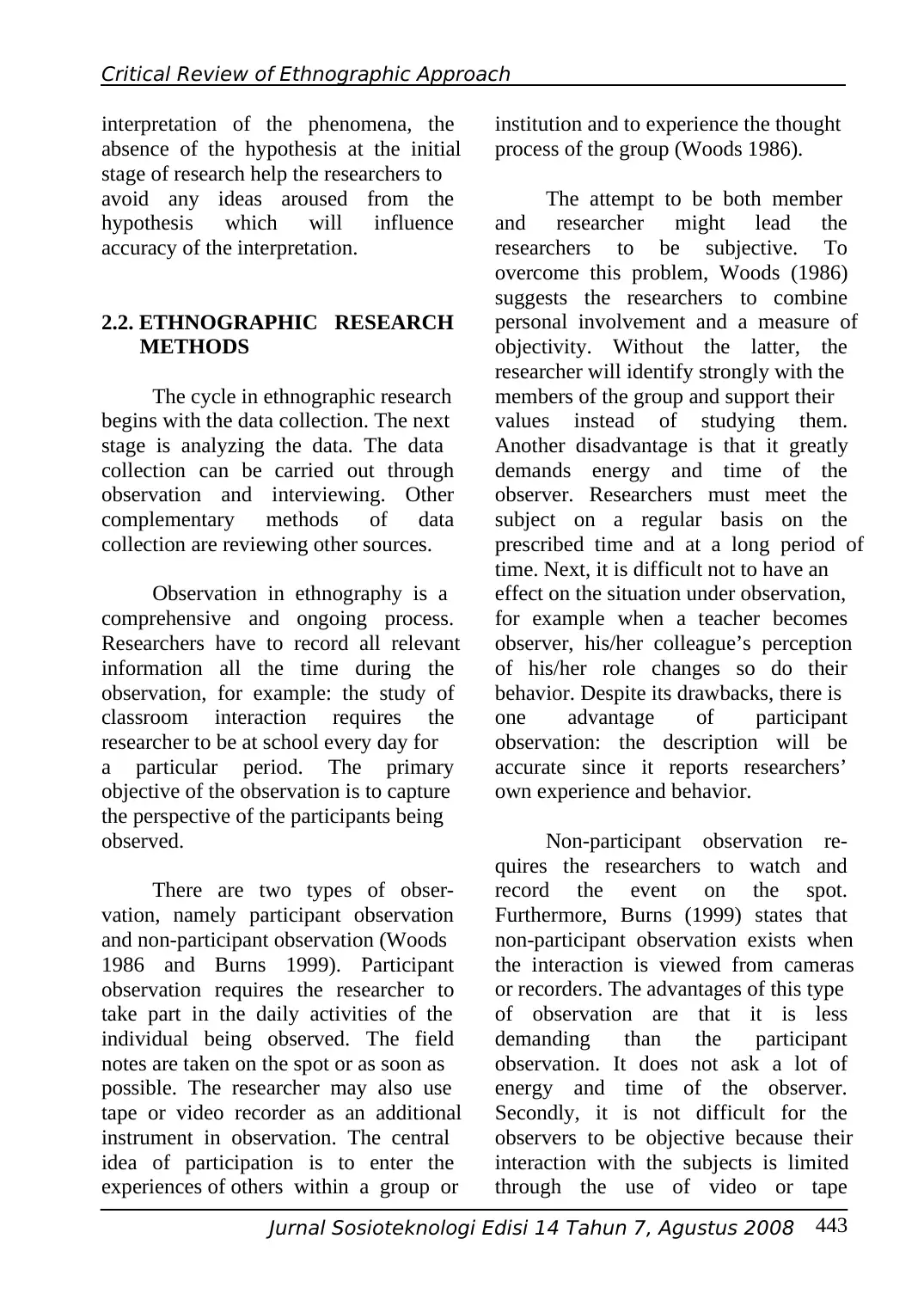
Critical Review of Ethnographic Approach
interpretation of the phenomena, the
absence of the hypothesis at the initial
stage of research help the researchers to
avoid any ideas aroused from the
hypothesis which will influence
accuracy of the interpretation.
2.2. ETHNOGRAPHIC RESEARCH
METHODS
The cycle in ethnographic research
begins with the data collection. The next
stage is analyzing the data. The data
collection can be carried out through
observation and interviewing. Other
complementary methods of data
collection are reviewing other sources.
Observation in ethnography is a
comprehensive and ongoing process.
Researchers have to record all relevant
information all the time during the
observation, for example: the study of
classroom interaction requires the
researcher to be at school every day for
a particular period. The primary
objective of the observation is to capture
the perspective of the participants being
observed.
There are two types of obser-
vation, namely participant observation
and non-participant observation (Woods
1986 and Burns 1999). Participant
observation requires the researcher to
take part in the daily activities of the
individual being observed. The field
notes are taken on the spot or as soon as
possible. The researcher may also use
tape or video recorder as an additional
instrument in observation. The central
idea of participation is to enter the
experiences of others within a group or
institution and to experience the thought
process of the group (Woods 1986).
The attempt to be both member
and researcher might lead the
researchers to be subjective. To
overcome this problem, Woods (1986)
suggests the researchers to combine
personal involvement and a measure of
objectivity. Without the latter, the
researcher will identify strongly with the
members of the group and support their
values instead of studying them.
Another disadvantage is that it greatly
demands energy and time of the
observer. Researchers must meet the
subject on a regular basis on the
prescribed time and at a long period of
time. Next, it is difficult not to have an
effect on the situation under observation,
for example when a teacher becomes
observer, his/her colleague’s perception
of his/her role changes so do their
behavior. Despite its drawbacks, there is
one advantage of participant
observation: the description will be
accurate since it reports researchers’
own experience and behavior.
Non-participant observation re-
quires the researchers to watch and
record the event on the spot.
Furthermore, Burns (1999) states that
non-participant observation exists when
the interaction is viewed from cameras
or recorders. The advantages of this type
of observation are that it is less
demanding than the participant
observation. It does not ask a lot of
energy and time of the observer.
Secondly, it is not difficult for the
observers to be objective because their
interaction with the subjects is limited
through the use of video or tape
Jurnal Sosioteknologi Edisi 14 Tahun 7, Agustus 2008 443
interpretation of the phenomena, the
absence of the hypothesis at the initial
stage of research help the researchers to
avoid any ideas aroused from the
hypothesis which will influence
accuracy of the interpretation.
2.2. ETHNOGRAPHIC RESEARCH
METHODS
The cycle in ethnographic research
begins with the data collection. The next
stage is analyzing the data. The data
collection can be carried out through
observation and interviewing. Other
complementary methods of data
collection are reviewing other sources.
Observation in ethnography is a
comprehensive and ongoing process.
Researchers have to record all relevant
information all the time during the
observation, for example: the study of
classroom interaction requires the
researcher to be at school every day for
a particular period. The primary
objective of the observation is to capture
the perspective of the participants being
observed.
There are two types of obser-
vation, namely participant observation
and non-participant observation (Woods
1986 and Burns 1999). Participant
observation requires the researcher to
take part in the daily activities of the
individual being observed. The field
notes are taken on the spot or as soon as
possible. The researcher may also use
tape or video recorder as an additional
instrument in observation. The central
idea of participation is to enter the
experiences of others within a group or
institution and to experience the thought
process of the group (Woods 1986).
The attempt to be both member
and researcher might lead the
researchers to be subjective. To
overcome this problem, Woods (1986)
suggests the researchers to combine
personal involvement and a measure of
objectivity. Without the latter, the
researcher will identify strongly with the
members of the group and support their
values instead of studying them.
Another disadvantage is that it greatly
demands energy and time of the
observer. Researchers must meet the
subject on a regular basis on the
prescribed time and at a long period of
time. Next, it is difficult not to have an
effect on the situation under observation,
for example when a teacher becomes
observer, his/her colleague’s perception
of his/her role changes so do their
behavior. Despite its drawbacks, there is
one advantage of participant
observation: the description will be
accurate since it reports researchers’
own experience and behavior.
Non-participant observation re-
quires the researchers to watch and
record the event on the spot.
Furthermore, Burns (1999) states that
non-participant observation exists when
the interaction is viewed from cameras
or recorders. The advantages of this type
of observation are that it is less
demanding than the participant
observation. It does not ask a lot of
energy and time of the observer.
Secondly, it is not difficult for the
observers to be objective because their
interaction with the subjects is limited
through the use of video or tape
Jurnal Sosioteknologi Edisi 14 Tahun 7, Agustus 2008 443
⊘ This is a preview!⊘
Do you want full access?
Subscribe today to unlock all pages.

Trusted by 1+ million students worldwide
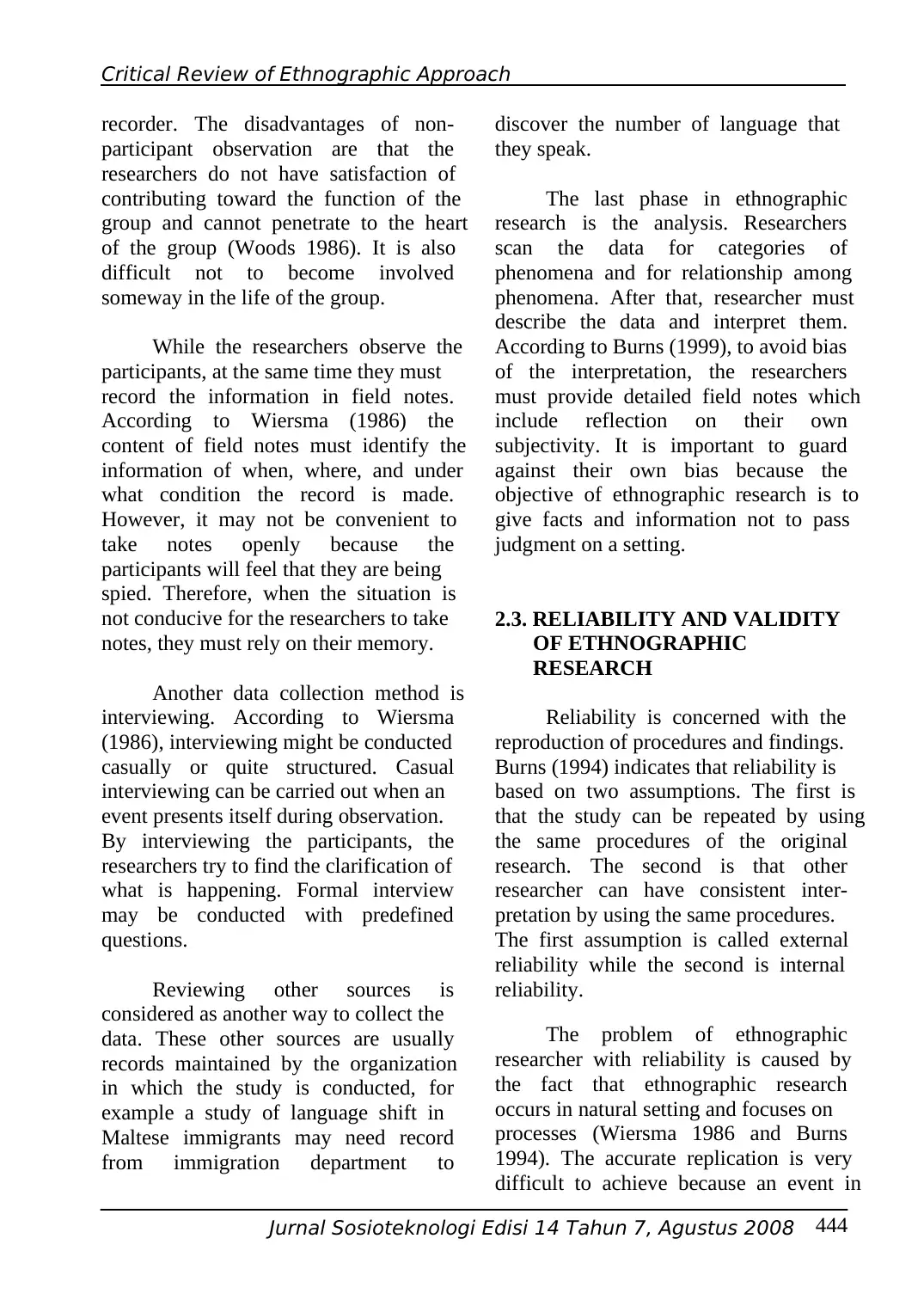
Critical Review of Ethnographic Approach
recorder. The disadvantages of non-
participant observation are that the
researchers do not have satisfaction of
contributing toward the function of the
group and cannot penetrate to the heart
of the group (Woods 1986). It is also
difficult not to become involved
someway in the life of the group.
While the researchers observe the
participants, at the same time they must
record the information in field notes.
According to Wiersma (1986) the
content of field notes must identify the
information of when, where, and under
what condition the record is made.
However, it may not be convenient to
take notes openly because the
participants will feel that they are being
spied. Therefore, when the situation is
not conducive for the researchers to take
notes, they must rely on their memory.
Another data collection method is
interviewing. According to Wiersma
(1986), interviewing might be conducted
casually or quite structured. Casual
interviewing can be carried out when an
event presents itself during observation.
By interviewing the participants, the
researchers try to find the clarification of
what is happening. Formal interview
may be conducted with predefined
questions.
Reviewing other sources is
considered as another way to collect the
data. These other sources are usually
records maintained by the organization
in which the study is conducted, for
example a study of language shift in
Maltese immigrants may need record
from immigration department to
discover the number of language that
they speak.
The last phase in ethnographic
research is the analysis. Researchers
scan the data for categories of
phenomena and for relationship among
phenomena. After that, researcher must
describe the data and interpret them.
According to Burns (1999), to avoid bias
of the interpretation, the researchers
must provide detailed field notes which
include reflection on their own
subjectivity. It is important to guard
against their own bias because the
objective of ethnographic research is to
give facts and information not to pass
judgment on a setting.
2.3. RELIABILITY AND VALIDITY
OF ETHNOGRAPHIC
RESEARCH
Reliability is concerned with the
reproduction of procedures and findings.
Burns (1994) indicates that reliability is
based on two assumptions. The first is
that the study can be repeated by using
the same procedures of the original
research. The second is that other
researcher can have consistent inter-
pretation by using the same procedures.
The first assumption is called external
reliability while the second is internal
reliability.
The problem of ethnographic
researcher with reliability is caused by
the fact that ethnographic research
occurs in natural setting and focuses on
processes (Wiersma 1986 and Burns
1994). The accurate replication is very
difficult to achieve because an event in
Jurnal Sosioteknologi Edisi 14 Tahun 7, Agustus 2008 444
recorder. The disadvantages of non-
participant observation are that the
researchers do not have satisfaction of
contributing toward the function of the
group and cannot penetrate to the heart
of the group (Woods 1986). It is also
difficult not to become involved
someway in the life of the group.
While the researchers observe the
participants, at the same time they must
record the information in field notes.
According to Wiersma (1986) the
content of field notes must identify the
information of when, where, and under
what condition the record is made.
However, it may not be convenient to
take notes openly because the
participants will feel that they are being
spied. Therefore, when the situation is
not conducive for the researchers to take
notes, they must rely on their memory.
Another data collection method is
interviewing. According to Wiersma
(1986), interviewing might be conducted
casually or quite structured. Casual
interviewing can be carried out when an
event presents itself during observation.
By interviewing the participants, the
researchers try to find the clarification of
what is happening. Formal interview
may be conducted with predefined
questions.
Reviewing other sources is
considered as another way to collect the
data. These other sources are usually
records maintained by the organization
in which the study is conducted, for
example a study of language shift in
Maltese immigrants may need record
from immigration department to
discover the number of language that
they speak.
The last phase in ethnographic
research is the analysis. Researchers
scan the data for categories of
phenomena and for relationship among
phenomena. After that, researcher must
describe the data and interpret them.
According to Burns (1999), to avoid bias
of the interpretation, the researchers
must provide detailed field notes which
include reflection on their own
subjectivity. It is important to guard
against their own bias because the
objective of ethnographic research is to
give facts and information not to pass
judgment on a setting.
2.3. RELIABILITY AND VALIDITY
OF ETHNOGRAPHIC
RESEARCH
Reliability is concerned with the
reproduction of procedures and findings.
Burns (1994) indicates that reliability is
based on two assumptions. The first is
that the study can be repeated by using
the same procedures of the original
research. The second is that other
researcher can have consistent inter-
pretation by using the same procedures.
The first assumption is called external
reliability while the second is internal
reliability.
The problem of ethnographic
researcher with reliability is caused by
the fact that ethnographic research
occurs in natural setting and focuses on
processes (Wiersma 1986 and Burns
1994). The accurate replication is very
difficult to achieve because an event in
Jurnal Sosioteknologi Edisi 14 Tahun 7, Agustus 2008 444
Paraphrase This Document
Need a fresh take? Get an instant paraphrase of this document with our AI Paraphraser
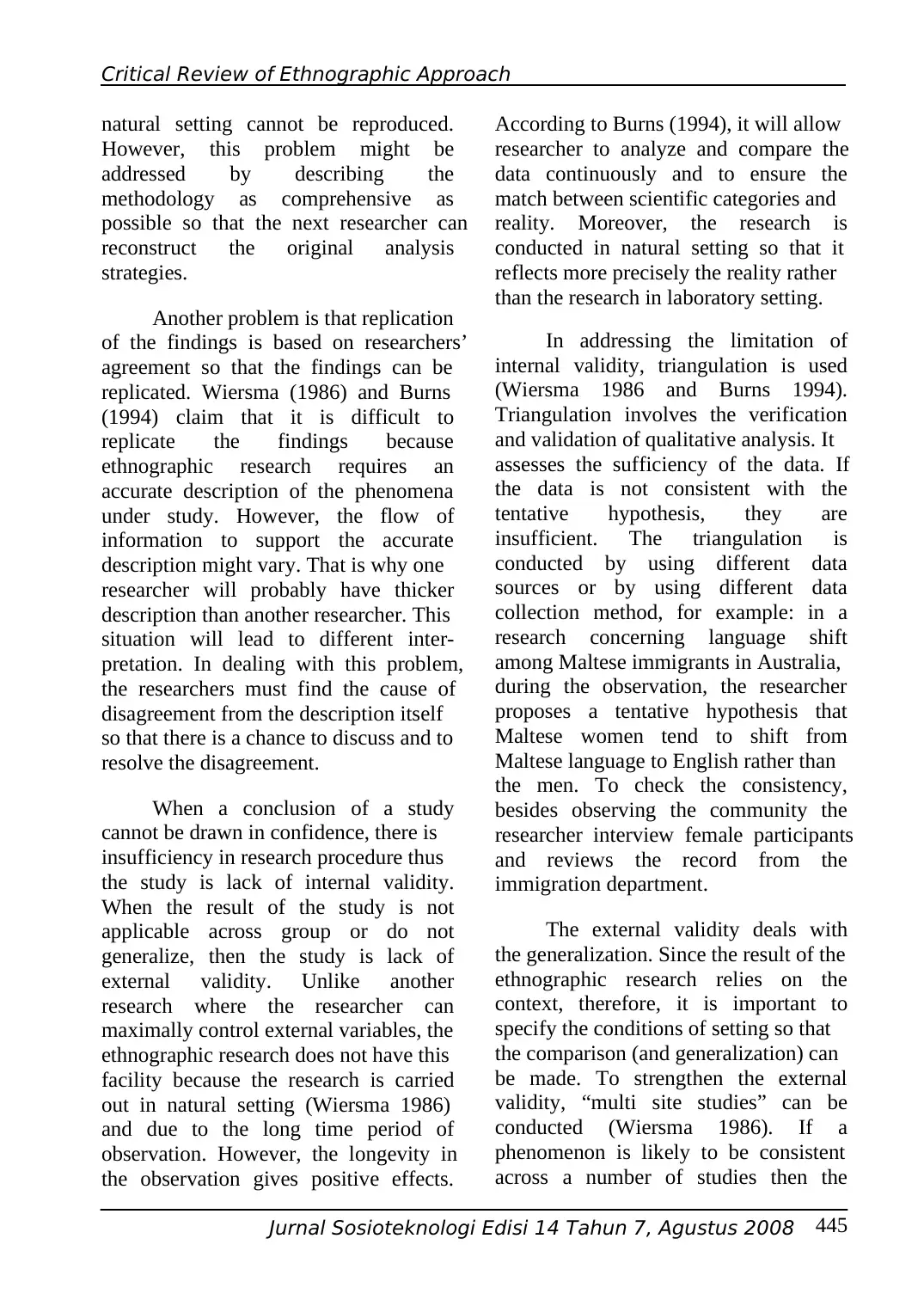
Critical Review of Ethnographic Approach
natural setting cannot be reproduced.
However, this problem might be
addressed by describing the
methodology as comprehensive as
possible so that the next researcher can
reconstruct the original analysis
strategies.
Another problem is that replication
of the findings is based on researchers’
agreement so that the findings can be
replicated. Wiersma (1986) and Burns
(1994) claim that it is difficult to
replicate the findings because
ethnographic research requires an
accurate description of the phenomena
under study. However, the flow of
information to support the accurate
description might vary. That is why one
researcher will probably have thicker
description than another researcher. This
situation will lead to different inter-
pretation. In dealing with this problem,
the researchers must find the cause of
disagreement from the description itself
so that there is a chance to discuss and to
resolve the disagreement.
When a conclusion of a study
cannot be drawn in confidence, there is
insufficiency in research procedure thus
the study is lack of internal validity.
When the result of the study is not
applicable across group or do not
generalize, then the study is lack of
external validity. Unlike another
research where the researcher can
maximally control external variables, the
ethnographic research does not have this
facility because the research is carried
out in natural setting (Wiersma 1986)
and due to the long time period of
observation. However, the longevity in
the observation gives positive effects.
According to Burns (1994), it will allow
researcher to analyze and compare the
data continuously and to ensure the
match between scientific categories and
reality. Moreover, the research is
conducted in natural setting so that it
reflects more precisely the reality rather
than the research in laboratory setting.
In addressing the limitation of
internal validity, triangulation is used
(Wiersma 1986 and Burns 1994).
Triangulation involves the verification
and validation of qualitative analysis. It
assesses the sufficiency of the data. If
the data is not consistent with the
tentative hypothesis, they are
insufficient. The triangulation is
conducted by using different data
sources or by using different data
collection method, for example: in a
research concerning language shift
among Maltese immigrants in Australia,
during the observation, the researcher
proposes a tentative hypothesis that
Maltese women tend to shift from
Maltese language to English rather than
the men. To check the consistency,
besides observing the community the
researcher interview female participants
and reviews the record from the
immigration department.
The external validity deals with
the generalization. Since the result of the
ethnographic research relies on the
context, therefore, it is important to
specify the conditions of setting so that
the comparison (and generalization) can
be made. To strengthen the external
validity, “multi site studies” can be
conducted (Wiersma 1986). If a
phenomenon is likely to be consistent
across a number of studies then the
Jurnal Sosioteknologi Edisi 14 Tahun 7, Agustus 2008 445
natural setting cannot be reproduced.
However, this problem might be
addressed by describing the
methodology as comprehensive as
possible so that the next researcher can
reconstruct the original analysis
strategies.
Another problem is that replication
of the findings is based on researchers’
agreement so that the findings can be
replicated. Wiersma (1986) and Burns
(1994) claim that it is difficult to
replicate the findings because
ethnographic research requires an
accurate description of the phenomena
under study. However, the flow of
information to support the accurate
description might vary. That is why one
researcher will probably have thicker
description than another researcher. This
situation will lead to different inter-
pretation. In dealing with this problem,
the researchers must find the cause of
disagreement from the description itself
so that there is a chance to discuss and to
resolve the disagreement.
When a conclusion of a study
cannot be drawn in confidence, there is
insufficiency in research procedure thus
the study is lack of internal validity.
When the result of the study is not
applicable across group or do not
generalize, then the study is lack of
external validity. Unlike another
research where the researcher can
maximally control external variables, the
ethnographic research does not have this
facility because the research is carried
out in natural setting (Wiersma 1986)
and due to the long time period of
observation. However, the longevity in
the observation gives positive effects.
According to Burns (1994), it will allow
researcher to analyze and compare the
data continuously and to ensure the
match between scientific categories and
reality. Moreover, the research is
conducted in natural setting so that it
reflects more precisely the reality rather
than the research in laboratory setting.
In addressing the limitation of
internal validity, triangulation is used
(Wiersma 1986 and Burns 1994).
Triangulation involves the verification
and validation of qualitative analysis. It
assesses the sufficiency of the data. If
the data is not consistent with the
tentative hypothesis, they are
insufficient. The triangulation is
conducted by using different data
sources or by using different data
collection method, for example: in a
research concerning language shift
among Maltese immigrants in Australia,
during the observation, the researcher
proposes a tentative hypothesis that
Maltese women tend to shift from
Maltese language to English rather than
the men. To check the consistency,
besides observing the community the
researcher interview female participants
and reviews the record from the
immigration department.
The external validity deals with
the generalization. Since the result of the
ethnographic research relies on the
context, therefore, it is important to
specify the conditions of setting so that
the comparison (and generalization) can
be made. To strengthen the external
validity, “multi site studies” can be
conducted (Wiersma 1986). If a
phenomenon is likely to be consistent
across a number of studies then the
Jurnal Sosioteknologi Edisi 14 Tahun 7, Agustus 2008 445
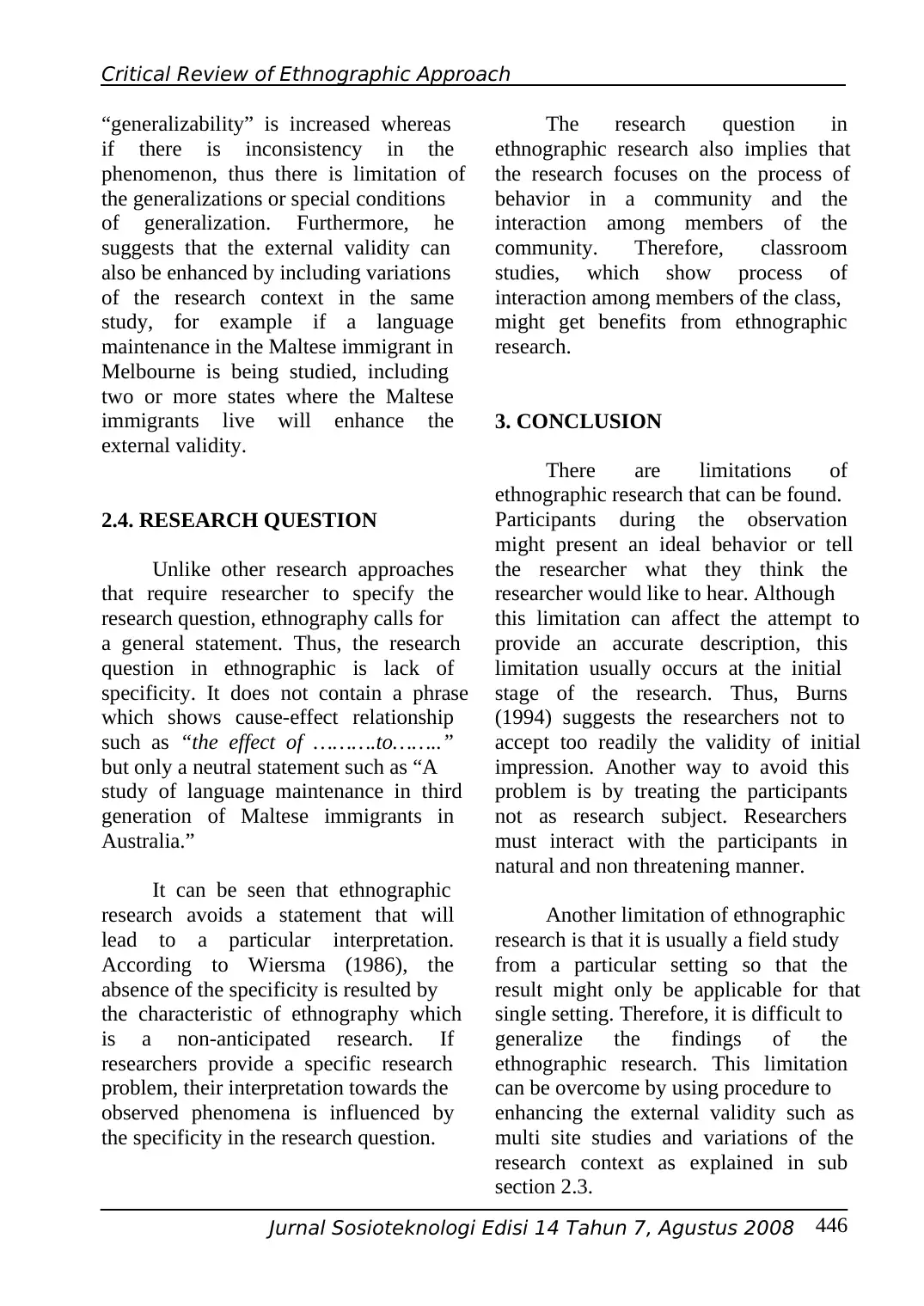
Critical Review of Ethnographic Approach
“generalizability” is increased whereas
if there is inconsistency in the
phenomenon, thus there is limitation of
the generalizations or special conditions
of generalization. Furthermore, he
suggests that the external validity can
also be enhanced by including variations
of the research context in the same
study, for example if a language
maintenance in the Maltese immigrant in
Melbourne is being studied, including
two or more states where the Maltese
immigrants live will enhance the
external validity.
2.4. RESEARCH QUESTION
Unlike other research approaches
that require researcher to specify the
research question, ethnography calls for
a general statement. Thus, the research
question in ethnographic is lack of
specificity. It does not contain a phrase
which shows cause-effect relationship
such as “the effect of ……….to……..”
but only a neutral statement such as “A
study of language maintenance in third
generation of Maltese immigrants in
Australia.”
It can be seen that ethnographic
research avoids a statement that will
lead to a particular interpretation.
According to Wiersma (1986), the
absence of the specificity is resulted by
the characteristic of ethnography which
is a non-anticipated research. If
researchers provide a specific research
problem, their interpretation towards the
observed phenomena is influenced by
the specificity in the research question.
The research question in
ethnographic research also implies that
the research focuses on the process of
behavior in a community and the
interaction among members of the
community. Therefore, classroom
studies, which show process of
interaction among members of the class,
might get benefits from ethnographic
research.
3. CONCLUSION
There are limitations of
ethnographic research that can be found.
Participants during the observation
might present an ideal behavior or tell
the researcher what they think the
researcher would like to hear. Although
this limitation can affect the attempt to
provide an accurate description, this
limitation usually occurs at the initial
stage of the research. Thus, Burns
(1994) suggests the researchers not to
accept too readily the validity of initial
impression. Another way to avoid this
problem is by treating the participants
not as research subject. Researchers
must interact with the participants in
natural and non threatening manner.
Another limitation of ethnographic
research is that it is usually a field study
from a particular setting so that the
result might only be applicable for that
single setting. Therefore, it is difficult to
generalize the findings of the
ethnographic research. This limitation
can be overcome by using procedure to
enhancing the external validity such as
multi site studies and variations of the
research context as explained in sub
section 2.3.
Jurnal Sosioteknologi Edisi 14 Tahun 7, Agustus 2008 446
“generalizability” is increased whereas
if there is inconsistency in the
phenomenon, thus there is limitation of
the generalizations or special conditions
of generalization. Furthermore, he
suggests that the external validity can
also be enhanced by including variations
of the research context in the same
study, for example if a language
maintenance in the Maltese immigrant in
Melbourne is being studied, including
two or more states where the Maltese
immigrants live will enhance the
external validity.
2.4. RESEARCH QUESTION
Unlike other research approaches
that require researcher to specify the
research question, ethnography calls for
a general statement. Thus, the research
question in ethnographic is lack of
specificity. It does not contain a phrase
which shows cause-effect relationship
such as “the effect of ……….to……..”
but only a neutral statement such as “A
study of language maintenance in third
generation of Maltese immigrants in
Australia.”
It can be seen that ethnographic
research avoids a statement that will
lead to a particular interpretation.
According to Wiersma (1986), the
absence of the specificity is resulted by
the characteristic of ethnography which
is a non-anticipated research. If
researchers provide a specific research
problem, their interpretation towards the
observed phenomena is influenced by
the specificity in the research question.
The research question in
ethnographic research also implies that
the research focuses on the process of
behavior in a community and the
interaction among members of the
community. Therefore, classroom
studies, which show process of
interaction among members of the class,
might get benefits from ethnographic
research.
3. CONCLUSION
There are limitations of
ethnographic research that can be found.
Participants during the observation
might present an ideal behavior or tell
the researcher what they think the
researcher would like to hear. Although
this limitation can affect the attempt to
provide an accurate description, this
limitation usually occurs at the initial
stage of the research. Thus, Burns
(1994) suggests the researchers not to
accept too readily the validity of initial
impression. Another way to avoid this
problem is by treating the participants
not as research subject. Researchers
must interact with the participants in
natural and non threatening manner.
Another limitation of ethnographic
research is that it is usually a field study
from a particular setting so that the
result might only be applicable for that
single setting. Therefore, it is difficult to
generalize the findings of the
ethnographic research. This limitation
can be overcome by using procedure to
enhancing the external validity such as
multi site studies and variations of the
research context as explained in sub
section 2.3.
Jurnal Sosioteknologi Edisi 14 Tahun 7, Agustus 2008 446
⊘ This is a preview!⊘
Do you want full access?
Subscribe today to unlock all pages.

Trusted by 1+ million students worldwide
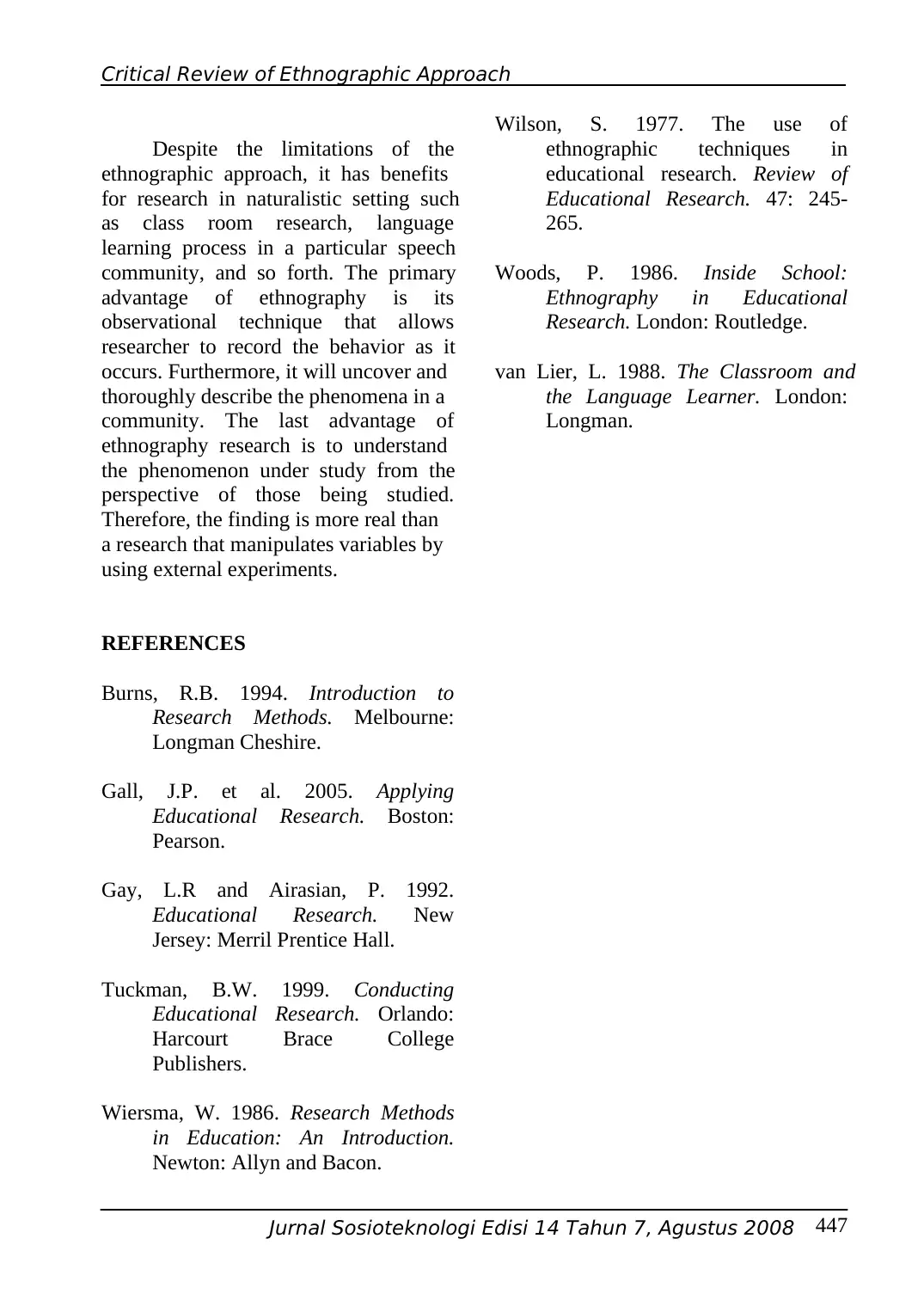
Critical Review of Ethnographic Approach
Despite the limitations of the
ethnographic approach, it has benefits
for research in naturalistic setting such
as class room research, language
learning process in a particular speech
community, and so forth. The primary
advantage of ethnography is its
observational technique that allows
researcher to record the behavior as it
occurs. Furthermore, it will uncover and
thoroughly describe the phenomena in a
community. The last advantage of
ethnography research is to understand
the phenomenon under study from the
perspective of those being studied.
Therefore, the finding is more real than
a research that manipulates variables by
using external experiments.
REFERENCES
Burns, R.B. 1994. Introduction to
Research Methods. Melbourne:
Longman Cheshire.
Gall, J.P. et al. 2005. Applying
Educational Research. Boston:
Pearson.
Gay, L.R and Airasian, P. 1992.
Educational Research. New
Jersey: Merril Prentice Hall.
Tuckman, B.W. 1999. Conducting
Educational Research. Orlando:
Harcourt Brace College
Publishers.
Wiersma, W. 1986. Research Methods
in Education: An Introduction.
Newton: Allyn and Bacon.
Wilson, S. 1977. The use of
ethnographic techniques in
educational research. Review of
Educational Research. 47: 245-
265.
Woods, P. 1986. Inside School:
Ethnography in Educational
Research. London: Routledge.
van Lier, L. 1988. The Classroom and
the Language Learner. London:
Longman.
Jurnal Sosioteknologi Edisi 14 Tahun 7, Agustus 2008 447
Despite the limitations of the
ethnographic approach, it has benefits
for research in naturalistic setting such
as class room research, language
learning process in a particular speech
community, and so forth. The primary
advantage of ethnography is its
observational technique that allows
researcher to record the behavior as it
occurs. Furthermore, it will uncover and
thoroughly describe the phenomena in a
community. The last advantage of
ethnography research is to understand
the phenomenon under study from the
perspective of those being studied.
Therefore, the finding is more real than
a research that manipulates variables by
using external experiments.
REFERENCES
Burns, R.B. 1994. Introduction to
Research Methods. Melbourne:
Longman Cheshire.
Gall, J.P. et al. 2005. Applying
Educational Research. Boston:
Pearson.
Gay, L.R and Airasian, P. 1992.
Educational Research. New
Jersey: Merril Prentice Hall.
Tuckman, B.W. 1999. Conducting
Educational Research. Orlando:
Harcourt Brace College
Publishers.
Wiersma, W. 1986. Research Methods
in Education: An Introduction.
Newton: Allyn and Bacon.
Wilson, S. 1977. The use of
ethnographic techniques in
educational research. Review of
Educational Research. 47: 245-
265.
Woods, P. 1986. Inside School:
Ethnography in Educational
Research. London: Routledge.
van Lier, L. 1988. The Classroom and
the Language Learner. London:
Longman.
Jurnal Sosioteknologi Edisi 14 Tahun 7, Agustus 2008 447
1 out of 7
Related Documents
Your All-in-One AI-Powered Toolkit for Academic Success.
+13062052269
info@desklib.com
Available 24*7 on WhatsApp / Email
![[object Object]](/_next/static/media/star-bottom.7253800d.svg)
Unlock your academic potential
Copyright © 2020–2025 A2Z Services. All Rights Reserved. Developed and managed by ZUCOL.





